|
Nancy Brashear and Carolyn Angus As we finished the weeding of books published in 2023 from our bookshelves to make room for new releases, we became aware of the nonfiction books for older readers we had read but not reviewed that were too good to miss. Here are ten of these books that we would love to see in every middle school and high school library. 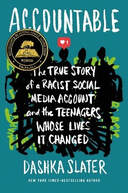 Accountable: The True Story of a Racist Social Media Account and the Teenagers Whose Lives It Changed. Dashka Slater. (2023). Farrar Straus Giroux. “Looking back, it’s hard not to wonder how the whole thing could have prevented.” Slater’s first sentence in the prologue sets readers up for contemplating the consequences of their own online activities as they read the true story of the private Instagram account with racist and sexist memes created by a junior at Albany High School in the small town of Albany, California. The nonfiction narrative, presented from multiple perspectives in 15 parts from “Before” to “Making It Through,” chronicles the complexity of effects that the discovery of the social media account in 2017 had on the lives of the girls targeted by the posts and the teenagers who followed them, as well as parents, student body, teachers, administrators, and the community of Albany. More generally, Slater also considers timely issues of accountability and complicity in the internet culture and its effects on the mental health of young people. (note on sourcing, acknowledgments, endnotes) (Gr 9-12) 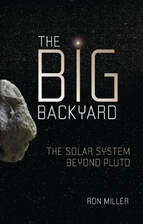 The Big Backyard: The Solar System Beyond Pluto. Ron Miller. (2023). Twenty-First Century. Miller begins with a succinct consideration of how astronomers came to understand the formation of our solar system 4.5 billion years ago and a brief history of the planets including the discoveries of Uranus by Sir William Herschel in 1781, Neptune by John Couch Adams in 1846, and Pluto in the Kuiper Belt by Clyde Tombaugh in 1930. He then focuses on exploration of the outer limits of the solar system and the latest discoveries, as well as new mysteries, arising from advances in telescopes used by astronomers in observatories and NASA missions. Miller includes interest-catching sidebars and captioned diagrams, charts, and photographs that support this informative and accessible text. In the conclusion, he points out that with each new question answered by astronomers, there are more discoveries to be made, and even more mysteries to be solved, about the “big backyard” of our solar system. (glossary, source notes, selected bibliography, sources of further information, index) (Gr 6 Up) 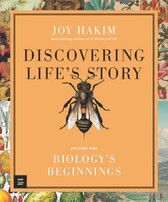 Biology’s Beginnings (Discovering Life’s Story #1). Joy Hakim. (2023). MITeen. In this first book of her new four-part series, Hakim delves into the history of human discoveries about life science and medicine. Each of the 12 chapters opens with two quotations and features the contributions of key figures from a particular era up to the late 1800s. For example, Chapter 4, “A Philosopher Named Bacon and a Bloody Doctor,” examines the profound effect on the field of life science of two of the “most important thinkers” in Elizabethan England: Francis Bacon (1561-1626) and William Harvey (1578-1657); Chapter 10, “A Big-Time Adventurer and a Quiet Scholar,” considers the collaboration of two German scientists, naturalist and explorer Baron Friedrich von Humboldt (1769-1859) and micropaleontologist Christian Ehrenberg (1795-1876), who explored and gathered specimens in Russia, central Asia, and Siberia in the 19th century when little was known about the microbial world. Hakim’s narrative is complemented by captioned portraits, photographs, diagrams, drawings, and artwork. The second volume of Discovering Life’s Story, The Evolution of an Idea, will be published in April 2024. (further reading, source notes, bibliography, index) (Gr 9-12) 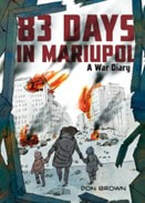 83 Days in Mariupol: A War Diary. Don Brown. (2023). Clarion. This nonfiction graphic novel war diary opens with a map pinpointing the location of Mariupol in southeastern Ukraine and the prologue, “Ukraine, Russia, and the Clatter of History,” setting the scene for a record of the 83-day siege of Mariupol. Brown’s panels of expressive pen-and-ink drawings portray the brave and heroic resistance of the Ukrainian people as well as the horrific death and destruction of the city beginning on February 24 and ending on May 17, 2022, accompanied by spare narrative text, speech bubbles, and primary source quotes. Russia’s invasion of Mariupol, a strategically-located port city on the Sea of Azov, results in 20,000 civilian deaths with 90 percent of the city destroyed. Brown states in the afterword that as of January 2023, Mariupol remains under Russian control. “Cold weather looms. Bombs, rockets, and explosive drones fall across Ukraine. Mariupol awaits liberation. Death is common currency. Peace seems far off.” (source notes, selected bibliography) (Gr 6 Up) 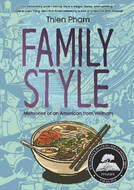 Family Style: Memories of an American from Vietnam. Thien Pham. (2023). First Second. Food memories play an important role in Vietnamese American Thien Pham’s graphic memoir. Each of the eight chapters is titled with the name of a dish associated with his family’s experiences as immigrants. He begins with his memory of being a five-year-old child fleeing war-ravaged Vietnam with his family in a small over-crowded boat and eating a rice and fish ball he clutched in his hand during an attack by pirates. The family survives in a refugee camp in Thailand where his mother cooks and sells bánh cuốn while they wait for relocation to the United States where their first American meal upon arrival in San Jose, California, was steak and potatoes. In other chapters, Thien Pham recalls discovering the American food he liked (strawberries and potato chips) or disliked (Salisbury steak in the school cafeteria), until in the final chapter, at the age of 41, he celebrates his new American citizenship by eating a fish and rice dish with his family. (photographs, endnotes) (Gr 6 Up) 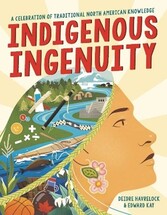 Indigenous Ingenuity: A Celebration of Traditional North American Knowledge. Deidre Havrelock & Edward Kay. Illus. by Kalila Fuller. (2023). Christy Octaviano. For millennia, Indigenous peoples across North America have made important contributions in science, technology, engineering, mathematics, and other areas. In an introductory note, Havrelock and Kay share their vision of Indigenous Ingenuity to celebrate traditional North American Indigenous innovation and “to embrace the mindset of reciprocity, responsibility, and relationship.” A conversational text complemented by illustrations, charts, maps, photographs, sidebars, and activities introduces readers to chapters on sustainable land management and ecology; transportation; communications technology; agriculture and food technology; health sciences; textile technology, clothing, and fashion; architecture and civil engineering; hunting and combat technology; mathematics; arts, sports, and recreation; and traditional ecological knowledge for a sustainable future. In the epilogue, the authors end with the thought that the Traditional Knowledge and Traditional Ecological Knowledge celebrated throughout the book are not only a part of Indigenous history but North American history also. (map of Indigenous peoples’ cultural areas across the continent, cultural areas and peoples referenced, glossary, contemporary Indigenous science organizations, selected bibliography, source notes, index) (Gr 6-8) 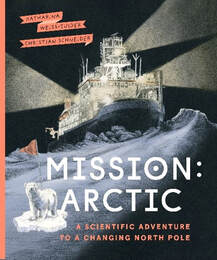 Mission: Arctic: A Scientific Adventure to a Changing North Pole. Katharina Weiss-Tuider. Trans. by Shelley Tanaka. Illus. by Christian Schneider. (2023). Greystone Kids. Weiss-Tuider takes readers on the largest expedition ever made to the Arctic, which polar and atmospheric scientist Markus Rex, the expedition leader, calls “the epicenter of climate change” in the foreword, “Frozen in the Ice.” The 2019 MOSAiC (Multidisciplinary drifting Observatory for the Study of Arctic Climate) expedition aboard the Polarstern, a German icebreaker research vessel, took scientists from all over the world on a 13-month mission that began in September which involved a plan to let the vessel freeze in the sea ice and drift across the Arctic Ocean towards the North Pole to study changes in the Arctic climate system. This well-designed book is organized in three parts: “The Biggest Arctic of All Time,” “Climate Research on the Ice,” and “Our Arctic, Our Future.” Each part includes a series of double spreads packed with an informative text, maps, photographs, labeled drawings, logbook notes, and other insets. (glossary, acknowledgments, photo credits, index) (Gr 6 Up) 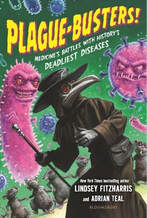 Plague-Busters!: Medicine’s Battles with History’s Deadliest Diseases. Lindsey Fitzharris & Adrian Teal. Illus. by Adrian Teal. (2023). Bloomsbury. Plague-Busters! is an engrossing (and at times, gross) history of the conquering of six of the world’s deadliest diseases: bubonic plague, smallpox, rabies, tuberculosis, cholera, and scurvy. Fitzharris and Teal share stories of the symptoms, theories on causes, treatments, and medical breakthroughs of these diseases with a dose of witty humor in the text and Teal’s cartoons and caricatures, done in black and white with touches of red. Each entry includes a “Bills of Mortality” section. For example, famous deaths from tuberculosis include 1553: Edward VI, King of England; 1642: Armand Jean du Plessis, Cardinal Richelieu; 1817: Jane Austen, English author; 1845: President Andrew Jackson; and 1962: First Lady Eleanor Roosevelt. In the afterword, the authors remind readers that new medical discoveries are often built on ideas that have come before and ask: “What will future generations think of us today?” (acknowledgments, selected sources, further reading, index) (Gr 6 Up) 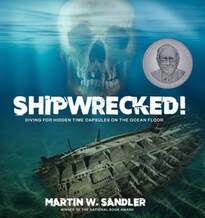 Shipwrecked!: Diving for Hidden Time Capsules on the Ocean Floor. Martin W. Sandler. (2023). Astra. Sandler’s engaging narratives of seven historical shipwrecks are accompanied by captioned photographs, maps, archival images, and insets with related information. Each entry expands readers’ knowledge in specific areas of content. For example, the first chapter chronicles the underwater excavations at the site of the Antikythera shipwreck in the first century, which was discovered in 1900 by sponge divers in the channel between the Greek islands of Antikythera and Crete, and is recognized as the “cradle of underwater archaeology.” Among the artifacts collected in what was essentially a salvage operation of ancient Greek works of art was a mysterious device that became known as the Antikythera Mechanism, the world’s first computer. In a final chapter, Sandler describes nine additional shipwrecks, including the naval warship USS Monitor, which sank in stormy waters off Cape Hatteras, North Carolina, on December 31, 1862, that readers might want to explore further. (source notes, select bibliography, image credits) (Gr 6 Up) 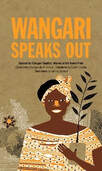 Wangari Speaks Out (Speak Out #3). Wangari Maathai. Commentary by Laia de Ahumada. Trans. by Susan Ouriou. Illus. by Vanina Starkoff. (2023). Groundwood. “Sustainable development, democracy and peace are indivisible.” Wangari Speaks Out presents the 2004 Nobel Peace Prize acceptance speech of environmental, social, and political activist Wangari Maathai (1940-2011), the first African woman and the first environmentalist to receive the prize, in an inviting format with pulled quotes printed in orange in a large font size and a stunning stylized illustration in orange, black, and brown on each double-page spread. Having grown up witnessing Kenyan forests being cleared and replaced by commercial plantations, Wangari was inspired to start the Green Belt Movement in 1977, which began with women planting trees in rural Africa and grew into an environmental and political battle. Since then, the movement has planted over fifty million trees in Kenya to improve the environment and people’s lives. In the second half of the book, de Ahumada provides commentary on key points of Wangari Maathai’s Nobel speech. (source notes) (Gr 6 Up) Nancy Brashear is Professor Emeritus of English at Azusa Pacific University, in Azusa, California. Carolyn Angus is former Director of the George G. Stone Center for Children’s Books, Claremont Graduate University, in Claremont, California.
0 Comments
Nancy Brashear and Carolyn Angus As reviewers, we weed our bookshelves each January to make room for new releases. As book lovers, we add some books to our personal collections and put some aside for grandchildren and special friends. As advocates of reading, we will send the others to schools and libraries, but before we do, here is our list of books published in 2023 that are too good to miss—books we would love to see in the hands of all children and teachers. 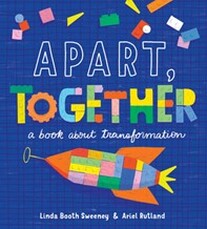 Apart, Together: A Book About Transformation. Linda Booth Sweeney. Illus. by Ariel Rutland. (2023). Balzer + Bray. Together, Sweeney’s lyrical text and Rutland’s bold, colorful double-spread illustrations present a child-friendly introduction to how separate things can become something new when they come together. Apart, Together begins with simple pairings. For example, “APART, blue is blue and / yellow is yellow, but . . . // TOGETHER, they make green!” The transformations then become more complicated and metaphorical. For example, at soccer practice, “APART, players kick a ball . . . // TOGETHER they score!” (PreS Up) 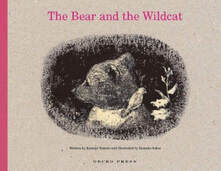 The Bear and the Wildcat. Kazumi Yumoto. Illus. by Komako Sakai. (2023). Gecko. “One morning, Bear was crying. His best friend, a little bird, was dead.” This beautifully crafted picture book tells the story of Bear’s inconsolable grief until he meets a wildcat who understands his loss and helps him remember the special times he shared with the little bird. The wildcat, a traveling violinist, offers him friendship and a hopeful path of recovery with the gift of a tambourine and an invitation to join him in traveling as the Bear and Wildcat Band. (PreK Up) 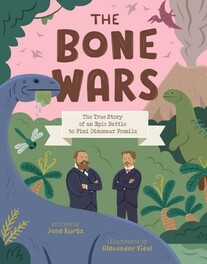 The Bone Wars: The True Story of the Epic Battle to Find Dinosaur Fossils. Jane Kurtz. Illus. by Alexander Vidal. (2023). Beach Lane. Meeting in 1863, paleontologists O. C. Marsh (1831-1899) and Edward Drinker Cope (1840-1897) became friends and collaborators until Marsh pointed out a mistake Cope made in attaching the skull to the tail of a dinosaur he named Elasmosaurus. “And that’s when . . . the Bone Wars began,” the bitter competition between the two fossil hunters to make the next big discovery. (author’s note, illustrator’s note, selected sources, suggested reading) (PrekUp) 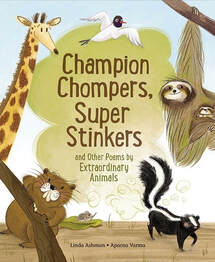 Champion Chompers, Super Stinkers and Other Poems by Extraordinary Animals. Linda Ashman. Illus. by Aparna Varma. (2023). Kids Can. A call for animal contestants becomes a guessing game to identify who takes first place. Each recto page features a mask poem and a part of the animal’s body. A page turn reveals the name, a portrait, and a paragraph of facts about the winner. Among the 18 winning contestants are peregrine falcon for fastest flyer, North American beaver for best engineer, and Etruscan shrew for smallest mammal. (protecting endangered animals, about measurements, about mask poems, recommended reading, glossary) (PreK Up) 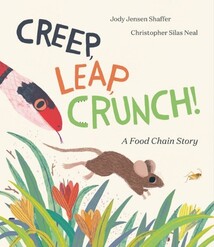 Creep, Leap, Crunch!: A Food Chain Story. Jody Jensen Shaeffer. Illus. by Christopher Silas Neal. (2023). Knopf. In this cumulative story, grass is nibbled by a cricket that is eaten by a brown deer mouse and so on up a simple food chain of consumers: a red milk snake, red hawk, red fox, and black bear. But some days, each animal alludes its predator, and the story ends with the bear munching “flowers and seeds … / …all that she needs,” and they all live to forage another day. (illustrated glossary) (PreK-Gr 2) 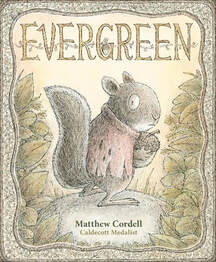 Evergreen. Matthew Cordell. (2023). Feiwel and Friends. Evergreen, a young squirrel who lacks courage, must conquer her fears when she must journey alone through Buckthorn Forest to deliver an empty acorn full of her mother’s healing soup to sick Granny Oak. Along the way, Evergreen hears strange noises, makes some friends, eludes some enemies, and almost loses the soup several times before delivering it safely to Granny Oak. Cordell’s animal fantasy with a lively text and detailed, ink-and-watercolor illustrations, organized in six parts during which Evergreen’s I-can-do-it confidence grows, has a surprise ending. (PreK Up) 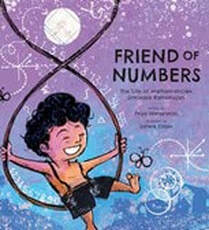 Friend of Numbers: The Life of Mathematician Srinivasa Ramanujan. Priya Narayanan. Illus. by Satwik Gade. (2023). Eerdmans. Growing up in southern India, Srinivasa Iyengar Ramanujan (1887-1920) was observant, full of questions, and fascinated with numbers. “They made patterns only he could see.” Traveling to England in 1914 to study mathematics under Professor Godfrey Hardy at Cambridge University, Ramanujan continued to discover more and more complex numerical patterns and gained worldwide recognition as a mathematical genius. (author’s note, patterns in numbers, sample problems, glossary) (PreK Up) 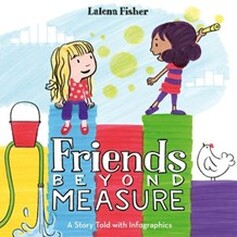 Friends Beyond Measure: A Story Told with Infographics. Lalena Fisher. (2023). Harper. Narrator Ana tells about becoming best friends with Harwin on the first day they meet and doing everything together—until Harwin reveals that her family is moving far away, and they must make plans for how to remain best friends forever. Young readers will delight in poring over the charts, diagrams, pictograms, maps, and other infographics in Fisher’s humorously detailed cartoon-like illustrations. (glossary of infographics with activities) (PreK Up) 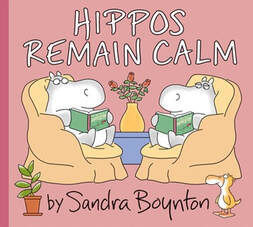 Hippos Remain Calm. Sandra Boynton. (2023) Boynton Bookworks. “Two fine hippos, / cozy at home, // take turns reciting / a morning-time poem” from The Big Book of Hippoetry. They calmly face some surprises during the day including a visit with one lonely friend that turns into a night of partying with a herd of hippos before they head home at dawn to snooze all morning long. For a fun read-aloud session, pair this rhyming picture book with Boynton’s first book, Hippos Go Berserk! (1977). (PreS Up) 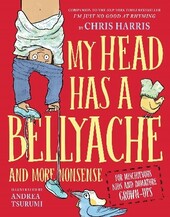 My Head Has a Bellyache: And More Nonsense for Mischievous Kids and Immature Grown-Ups (Mischievous Nonsense #2). Chris Harris. Illus. by Andrea Tsurumi. (2023). Little, Brown. From front cover to back cover, this companion to I’m Just Not Good at Rhyming (2017) is chock full of nonsense including silly rhymes, concrete poems, haiku, limericks, fractured fables, and other forms of creative wordplay. Harris’s energetic, snarky, and clever words spill across page after page with occasional hilarious footnotes, accompanied by Tsurumi’s cartoon-like illustrations, for a laugh-until-your-belly-hurts reading experience for all. (glossary, indices by title and subject) (PreK Up) 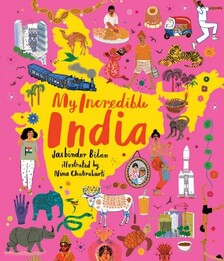 My Incredible India. Jasbinder Bilan. Illus. by Nina Chakrabarti. (2023). Candlewick. When she visits Nanijee (her grandmother), Thara takes one memento from an old trunk and hears a story of Nanijee’s travels all over India. Each entry in My Incredible India features a boxed section about the special object from the trunk (for example, a small metal tuk-tuk or a model of the Taj Mahal), where it came from, brief paragraphs of related facts, and numerous colorful illustrations with captions. (time line, biographical note on Mohandas Karamchand Gandhi, the Indian flag, index, resources) (Gr 3-5) 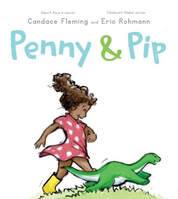 Penny & Pip. Candace Fleming. Illus. by Eric Rohmann. (2023). Caitlyn Dlouhy. On a class visit to the natural history museum, Penny sees a baby dinosaur hatching from an egg in a corner of a dinosaur exhibit, and the dinosaur sees Penny and follows her around the museum. In the lunchroom, he eats some of her cheese crackers, burps, and squeaks “Pip, pip.” In the Dinosaur Hall full of ancient skeletons, Penny realizes Pip is all alone and devises a clever plan to take him home with her and “into the future . . . together.” (PreK-Gr 2) 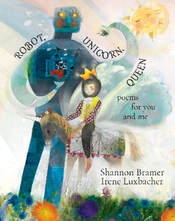 Robot, Unicorn, Queen: Poems for You and Me. Shannon Bramer. Illus. by Irene Luxbacher. (2023). Groundwood. Bramer’s new poetry collection, a companion to Climbing Shadows: Poems for Children (2019), explores various childhood experiences. Some of the 22 poems are playful and silly while others delve into thoughts and feelings from a child’s point of view. Luxbacher embellishes each poem with a stunning illustration created with watercolor, gouache, pencil, found paper, and digital collage. (author’s note) (PreK Up) 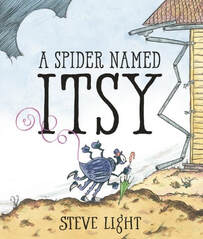 A Spider Named Itsy. Steve Light. (2023). Candlewick. With a spare, rhythmic text and playful ink-and-watercolor illustrations, Light elaborates on “The Itsy Bitsy Spider” nursery rhyme. On the fateful day after a tree limb fell and destroyed his web on a watering can, Itsy sets out to construct a new web under the gutter of a house and meets some other insects ascending the crooked waterspout. A heavy rain washes them back down but after the sun comes out, they all climb the spout again, and the story ends with “New web home, newfound friends.” (PreS Up) 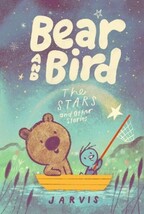 The Stars and Other Stories (Bear & Bird #2). Jarvis. (2023). Candlewick. In four short stories, unlikely best friends Bear and Bird quarrel over something silly and decide to get new best friends, have a surprise go awry, nearly lose each other, and discover that looking up at the stars with your “bestest” of friends is perfect. Jarvis’s crayon-like illustrations featuring these two charming characters add warmth and humor to the stories in this series for newly independent readers about the ups and downs of an enduring friendship. (PreK-Gr 2) 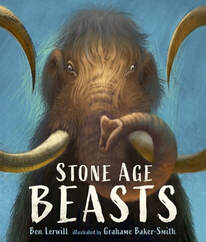 Stone Age Beasts. Ben Lerwill. Illus. by Grahame Baker-Smith. (2023). Candlewick. Following an introduction to the Stone Age, which started nearly three million years ago, Lerwill and Baker-Smith provide profiles of the wooly mammoth, elephant bird, Steller’s sea cow, and 15 other majestic animals that lived alongside humans then. Each double-spread entry includes a spectacular portrait and introductory paragraphs written in a conversational tone, smaller text boxes of other interesting facts, and a side bar with scientific name, weight, date of extinction, range (with map), and a comparison of its size to that of an adult human. (glossary) (Gr 3 Up) 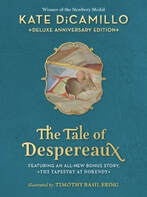 The Tale of Despereaux: Being the Story of a Mouse, a Princess, Some Soup, and a Spool of Thread (Deluxe Anniversary Edition). Kate DiCamillo. Illus. by Timothy Basil Ering. (2023). Candlewick. This 20th anniversary edition of The Tale of Despereaux includes a new short story, “The Tapestry at Norendy,” the perfect link between DiCamillo’s Newbery Medal-winning fanciful, adventurous tale about a heroic small mouse named Despereaux Tilling and The Norendy Tales, her new series of original fairy tales. The first book in the planned trilogy, The Puppets of Spelhhorst, was published in 2023; book two, The Hotel Balzaar, will be published in October 2024. (Gr 3-5) 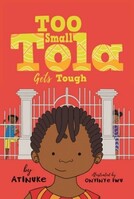 Too Small Tola Gets Tough (Too Small Tola #3). Atinuke. Illus. by Onyinye Iwu. (2023). Chronicle. Too Small Tola, who lives with Grandmommy and her older siblings, Moji and Dapo, in “a run-down block of apartments in the megacity of Lagos, in the country of Nigeria,” is worried when even her beloved megacity cannot fight off the deadly virus plaguing the world and goes into lockdown. In three episodic stories, Tola proves that she is small but mighty, as well as clever and resourceful, when she takes on her family’s economic challenges of surviving the pandemic. (PreK Up) 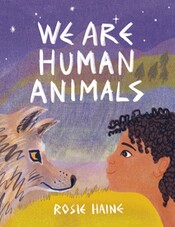 We Are Human Animals. Rosie Haine. (2023). Eerdmans. With a spare text and stunning double-spread illustrations, Haine introduces young readers to a family of Upper Paleolithic hunter-gathers living in what is now France about 25,000 years ago when planet Earth was very different. This accessible story of our Stone Age ancestors ends on a thought-provoking note: “This was tens of thousands of years ago, // The world is very different now, but . . . // We are still human animals.” (author’s note) (PreK Up) 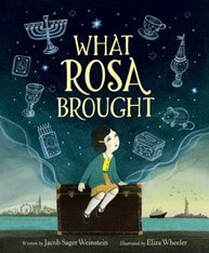 What Rosa Brought. Jacob Sager Weinstein. Illus. by Eliza Wheeler. (2023). Katherine Tegen. Young Rosa lived in Vienna, being cared for by Grandma, while her parents worked in the family’s grocery store. “Then the Nazis, came, and things changed.” With rising anti-Semitism making life dangerous for Jews and new rules that prohibit them from owning stores making survival difficult, the family eventually obtains three visas to America. Rosa wonders what she will bring with her, until Grandma, who will not be going, says Rosa will be taking her love with her. “And that’s what Rosa brought.” (authors note, photographs) (PreK Up) Nancy Brashear is Professor Emeritus of English from Azusa Pacific University, in Azusa, California. Carolyn Angus is former Director of the George G. Stone Center for Children’s Books, Claremont Graduate University, in Claremont, California.
Nancy Brashear and Carolyn Angus As reviewers, we read extensively in all genres of children’s and young adult fiction during the year and have done a lot of rereading during the last few months to select 20 of our favorite books published in 2023. 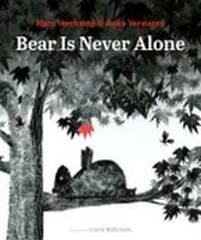 Bear Is Never Alone. Marc Veerkamp. Trans. by Laura Watkinson. Illus. by Jeska Verstegen. (2023). Eerdmans. The music of piano virtuoso Bear is so beautiful that all the forest animals, even the birds, are silent as he plays. When Bear stops, he hears “More, more, Piano Bear!” Seeking solitude, he runs away pursued by his audience and their cries for more songs. Finally, his “BIG ROOOOAAAAR” frightens them away. Bear is alone—until a lone zebra shows him that it is sometimes good to be alone together. Verstegen’s exquisite black-and-white illustrations include just a few touches of red. (PreK Up) 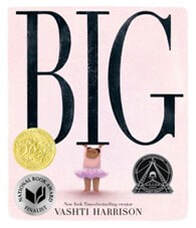 Big. Vashti Harrison. (2023). Little, Brown. Big begins with a Black baby girl with “a big laugh and a big heart and very big dreams.” As she grows older, the word “big” takes on a different meaning as she hears unkind remarks about her size in the classroom, on the playground, and at her dance studio. Harrison’s spare text and expressive pink-hued digital artwork tell the story of how the girl begins advocating for herself, letting people know that their words are hurtful and surrounding herself with words of self-acceptance and self-love. (author’s note) (PreK-Gr 2) 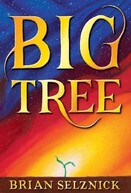 Big Tree. Brian Selznick. (2023). Scholastic. In his signature style of intertwining brief sections of text and expansive sections of exquisite graphite pencil artwork, Selznick creates an intriguing survival saga that begins late in the Cretaceous Period with the early release of two Sycamore seeds, Louise and Merwin, from their seedball during a forest fire, and they must use their wings to find a safe place to put down roots and grow. The final chapter, “Sixty-Six Million Years Later,” concludes with a seedling nurtured by a young child and father in a city. (afterword, selected bibliography, author’s note, index) (Gr 3 Up) 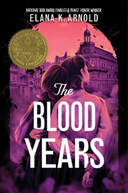 The Blood Years. Elana K. Arnold. (2023). Balzer + Bray. Based upon Arnold’s grandmother’s experiences during the Holocaust, The Blood Years is the compelling story of Jewish teen Frederieke (Reike) Teitler, whose life with her family (older sister Astra, mother, and grandfather Opa) changes drastically as their hometown Cernowitz, Romania, is occupied by the Soviets, then the Nazis, and then reoccupied by the Soviet between 1939 and 1945. Reike’s survival amid hatred, violence, and hunger is complicated by sexual abuse and life-threatening tuberculosis. (foreword, brief history of Cernowitz, author’s note, photographs, reading list) (Gr 9-12) 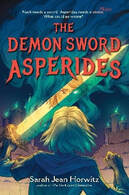 The Demon Sword Asperides. Sara Jean Horwitz. (2023). Algonquin. Thirteen-year-old Nack Furnival, a banished knight-in-training, seeks a quest but lacks a sword until he encounters Asperides, a powerful 2,000-year-old demon sword, in the burial cave of its former master, evil sorcerer Amyral Venir. After Amyral is resurrected, he recovers Asperides, planning to carve a doorway into the underworld to retrieve a missing piece of his soul and let demons loose on the world. Under the Missing Moon Prophecy, it becomes inevitable that the demon sword, the sorcerer, and the young teen will do battle upon the return of the missing third moon. (Gr 6-8) 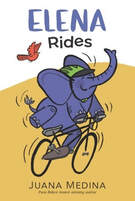 Elena Rides. Juana Medina. (2023). Candlewick. Elena, a purple elephant, wants to ride her bicycle. “She readies, / she steadies… // she pushes, / she pedals! // She wobbles / and bobbles . . . // KA-BANG!” After trying again and again with more spills and tears, Elena almost quits but with encouragement from her sidekick, a small red bird, she tries again. “Elena rides!” With its spare, rhythmic text and expressive cartoonlike illustrations, Elena Rides is both a good choice for beginning readers and a delightful read-aloud. Elena monta en bici was published simultaneously. (PreK-Gr 2) 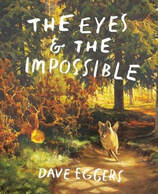 The Eyes and the Impossible. Dave Eggers. Illus. by Shawn Harris. (2023). Knopf. Johannes, a free dog, is the Eyes of the park near the sea where he lives. With the aid of his Assistant Eyes (a gull, pelican, squirrel, and racoon), he surveys the park and makes daily reports to the three ancient Bison living in a fenced-in enclosure who need to know about anything that might upset the park’s Equilibrium. When Johannes gets leashed while staring at a display of paintings and needs to be rescued from human Trouble Travelers by his friends, “the glory of liberation” makes him determined to free the Bison. (Gr 3 Up) 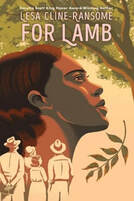 For Lamb. Lesa Cline-Ransome. (2023). Holiday House. In 1940 Jackson, Mississippi, Lamb, a Black teenage girl, secretly develops a friendship with Marny, a White girl, over a shared love of books in spite of the dangers of such a relationship in the Jim Crow South. Short chapters from the points of view of Lamb, her mother, her brother, Marny, and others tell of the terrorism, violence, and lynching that ensue. Cline-Ransome’s author’s note provides background on writing a novel about a female lynching victim as well as the history of lynching in the U.S. (Gr 9-12) 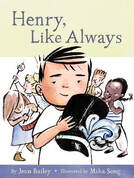 Henry, Like Always (Henry #1). Jenn Bailey. Illus. by Mika Song. (2023). Chronicle. When the class schedule changes because there will be a parade on Friday, Henry, who needs routine and order, is upset. Although his teacher and classmates try to make him feel comfortable, it is Henry who comes up with a plan that helps both himself and another upset classmate participate in the parade. Song’s expressive illustrations complement this warm and gently humorous first book in this early chapter book series about a young child who appears to be on the autism spectrum. (PreK-Gr 2) 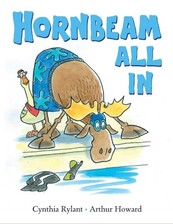 Hornbeam All In (Hornbeam #1). Cynthia Rylant. Illus. by Arthur Howard. (2023). Beach Lane. Rylant and Howard’s new early reader series introduces Hornbeam, a moose, in three humorous mini adventures. In “Eureka and the Picnic,” Hornbeam accepts goose Eureka’s invitation to a picnic that turns out to be a family reunion. In “Sleeping at Cuddy’s House,” Hornbeam’s snoring leaves Cuddy, a bull, ready for a cozy nap after a sleepless night. In “At the Pool with Adorable,” Hornbeam reluctantly takes swimming lessons from Adorabelle, a skunk, and earns his swimming certificate but still likes solid ground best. (PreK Up) 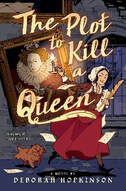 The Plot to Kill a Queen. Deborah Hopkinson. (2023). Scholastic. Thirteen-year-old lutist and aspiring playwright Emilia Bassano overhears two men plotting to kill “the imposter” and reports this to her guardian, Sir Francis Walsingham, Queen Elizabeth’s spymaster. He dispatches her as a court musician to Sheffield Castle—where Mary, Queen of Scots, is imprisoned—on a secret mission to foil the plot to kill Queen Elizabeth. Asides about theatrical productions, photographs, maps, and diagrams are interspersed throughout this spy story presented as a three-act play. (historical notes, timeline, Emilia’s one-act play “The Princess Saves the Cakes”—with production permission) (Gr 6-8) 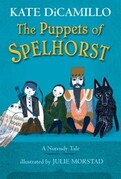 The Puppets of Spelhorst (Norendy Tales #1). Kate DiCamillo. Illus. by Julie Morstad. (2023). Candlewick. Retired sea captain Spelhorst buys five puppets—a girl (whose violet eyes remind him of Annalise, his long-lost love), king, wolf, boy, and owl—that must be purchased together. After Spelhorst’s death, his trunk with the puppets sold to the rag-and-bone man is purchased by a man for his young nieces, Emma and Martha, who involve the individual puppets in some perilous adventures before they are reunited in a play written by Emma and performed with the assistance of Martha and Jane Twiddum, the maid, that eerily mirrors the story of the Spelhorst and Annalise. (PreK Up) 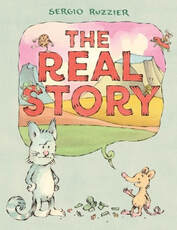 The Real Story. Sergio Ruzzier. (2023). Abrams Appleseed. Seeing a broken cookie jar and no cookies, Cat confronts Mouse. “How did it happen? And where are the cookies?” Mouse tells a silly story about the cookies jumping around until the jar fell off the table and then running away. After three more outrageous stories in response to Cat’s insistence on the real story, Mouse’s “I stole and ate all the cookies, and then the jar fell and broke” is so boring that Cat requests another original cookie story, which Mouse agrees to tell—for a cookie. (PreK-Gr 2) 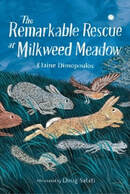 The Remarkable Rescue at Milkweed Meadow. Elaine Dimopoulos. Illus. by Doug Salati. (2023). Charlesbridge. Butternut is a young rabbit whose family uses storytelling to teach the truths that guide their lives: stories matter, rabbits have dignity, and stay alive. A rather anxious rabbit, she stays close to their burrow until she meets Piper, a fledgling robin who involves her in scary activities that have her breaking the family’s strict rules. As Butternut sneaks out at night, meeting and helping other Milkweed Meadow animals including an injured deer, she discovers that the world is not so terrifying. (Gr 3-5) 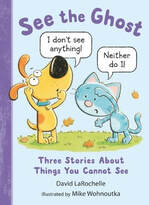 See the Ghost: Three Stories About Things You Cannot See (See the Cat #3). David LaRochelle. Illus. by Mike Wohnoutka. (2023). Candlewick. A simple text and cartoon illustrations with speech balloons offer a lesson on the concept of seeing versus not seeing something in three short stories: “See the Ghost,” “See the Wind,” and “See the Fairy.” Cat and dog from See the Cat (2020) and See the Dog (2021)—and the book itself—interact with invisible things in this clever primer that ends with “See the dog, / the cat, / the ghost, / the wind, / and the fairy / spend the afternoon / together.” (PreK-Gr 2) 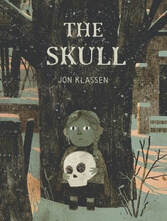 The Skull: A Tyrolean Folktale. Jon Klassen. (2023). Candlewick. Fleeing through a creepy forest one snowy night, runaway Otilla comes across an old house. Her knock at the door and “Hello” are answered by a lonely skull, who invites her in to shelter overnight. The skull’s warning that a headless skeleton will roam the house leads resourceful Otilla to devise a plan to respond to its cries of “GIVE ME THAT SKULL” and “I WANT THAT SKULL” in the middle of the night. Master storyteller Klassen’s adaptation of this traditional folktale is deliciously scary-but-not-too-scary. (author’s note) (PreK Up) 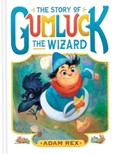 The Story of Gumluck the Wizard (Gumluck the Wizard #1). Adam Rex. (2023). Chronicle. In this humorous illustrated chapter book, narrator Helvetica (“Old Lady Crow” to Gumluck) tells how the “Little Wizard Who Lives in the Big Hill” tries to grant everyone’s wishes and yearns to be voted Harvest Hero at the Harvest Dance. Even after the Truth Fairy reveals that the ungrateful townsfolk mock him as the “Shrinking Wizard Who Lives Next to a Big Hole” whose spells usually go awry, Gumluck, with everyone believing in him, saves them all when the greedy King’s gold-laden castle topples from its mountain top. (PreK Up)  The Swifts: A Dictionary of Scoundrels. Beth Lincoln. Illus. by Claire Powell. (2023). Dutton. Thirteen-year-old Shenanigan Swift is excited to be attending the Swift Family Reunion, a gathering of relatives every ten years during which everyone hunts for Grand-Uncle Vile’s lost treasure hidden somewhere in Swift House. Her focus shifts from discovering the treasure to solving a mystery when the family matriarch Arch-Aunt Schadenfreude is shoved down the stairs. Shenanigan is determined to track down the killer—and prove herself more than the troublemaker that her name picked from the family dictionary suggests. (Gr 3 Up) 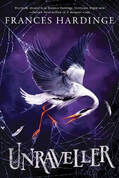 Unraveller. Frances Hardinge. (2023). Amulet. In this dark fantasy set in the country of Raddith where cursers abound, 15-year-olds Nettle (newly released from a curse as a heron) and Kellen (an unraveller of curses) are hired to hunt Jendy Pin, a curser who disappeared from a Chancery prison. As their quest takes them from Mizzleport to the Wilds to the Moonlit Market, they uncover the secret plot of Salvationists to overtake Chancery, the government of master merchants who rule Raddith. When a curse on Kellen intensifies his unraveling power, making him a danger to himself and everyone around him, he and Nettle must find a way to remove the curse if they are to save Raddith. (Gr 9-12) 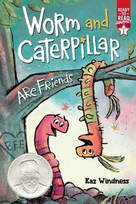 Worm and Caterpillar Are Friends (Ready-to-Read Graphics). Kaz Windness. (2023). Simon Spotlight. Worm believes he and Caterpillar are best friends because they are the same, but Caterpillar points out various ways in which they are different. Caterpillar also knows a change is coming and worries about what will happen to their friendship when he is no longer a caterpillar. In this Level 1 Ready-to-Read Graphics book, Windness’s expressive cartoon illustrations accompany the dialogue between Worm and Caterpillar to create an engaging story of a friendship that endures despite differences and change. (PreK-Gr 2) Nancy Brashear is Professor Emeritus of English at Azusa Pacific University, in Azusa, California. Carolyn Angus is former Director of the George G. Stone Center for Children’s Books, Claremont Graduate University, in Claremont, California.
|
AuthorsThese reviews are submitted by members of the International Literacy Association's Children's Literature and Reading Special Interest Group (CL/R SIG). Archives
March 2024
Categories
|

 RSS Feed
RSS Feed